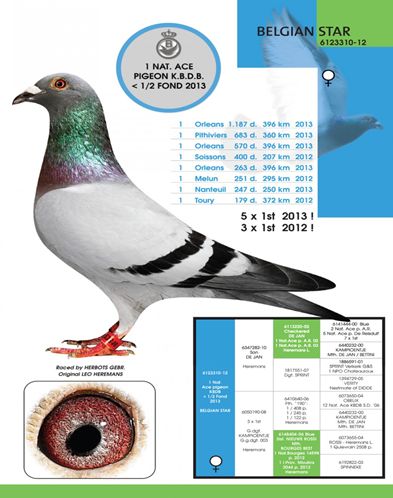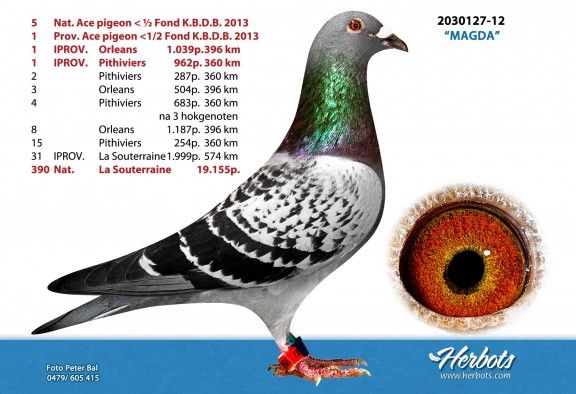Herbots Brothers – 1 national AS pigeon KBDB middle distance (years)
AS NATIONAL PIGEON KBDB MIDDLE DISTANCE (YEARS)
Halle-Booienhoven is located in the Belgian province of "Vlaams-Brabant". Halle-Booienhoven belongs to the city of Zoutleeuw and is also known that there are three provinces are adjacent: "Vlaams-Brabant", "Limburg" and "Luik". This region is known, that pigeon sports are carried out at the highest level. Also, this region is connected with the name HERBOTS.
We should let the facts for themselves... Herbots brothers can present an impressive list of results. Pigeon career is studded with national AS pigeons, national Siegen Olympiad title, finishes at the national championships of the KBDB. However the season 2013 was so far the best of all time! "Belgian Star" was 1 national AS pigeon of the KBDB on the medium-haul, "Magda" was 5th national AS pigeon KBDB middle distance at the year-old, "George" was the 9th National AS pigeon KBDB large medium-haul at the old pigeons! In the Belgian national team for Brno (Czech Republic), the Herbots team won the 1st and 2nd place in the category B (medium), the 1st and 2nd place category D (all-round), 2nd place category G (years old) and the 1st category H (youngsters). Provincial Championship KBDB Brabant, 6 x placed themselves among the first top-5 and took the title of the 1st provincial AS pigeon middle distance KBDB and 1 provincial AS pigeon large middle distance KBDB in the old pigeons!
Provincial Championship KBDB 2013
4th Prov. Champion > 1/2 Fund old (1 2) 2013
2. PR. Champion > 1/2 Fund year-old (1 2) 2013
1 PR. AS pigeon < ½ Fund 2013 (2030127-12)
2. PR. AS pigeon < ½ Fund 2013 (6123310-12) 1st Prov. AS pigeon > ½ Fund old 2013 (2192897-10)
3. PR. AS pigeon > ½ Fund year 2013 (2177233-12)
Total widower
Herbots brothers 2013 began the season with a team of 70 pairs which have been traveled on total widower... 250 youngsters and 45 breeding pairs, as well as 28 "world-famous" pigeons (national AS pigeons, national winner, Olympiad pigeons), which form the absolute Topper of the breeding shock.
After the season of 2012, especially after the flight of la Souterraine, the birds and the females stayed together and were separated again after 5 days breeding business. You mauserten then properly and with good Mauser lining and with much Methioforte...Sedochol and Herbial supplied. During the moulting period, the pigeons were no free flight.
The first mate took place on December 17 and all raised two young pigeons. When the youngsters were 15 days old the old pigeons were separated and the birds went to the boys. Free flight was from January.
End of March until the beginning of April has been mated to a second time, but birds and females stayed together for only 5 days. This second coupling is made only to train the pigeons quickly and effectively. The females stay on the trip beat, so that eliminates back and carry baskets from beat to beat. Four times, so the pigeons on 60 km - 70 km are trained if the weather allows it morning and evening. Then they fly Toury/Pithiviers, Soissons and La Souterraine from MOMIGNIES, 2 x.
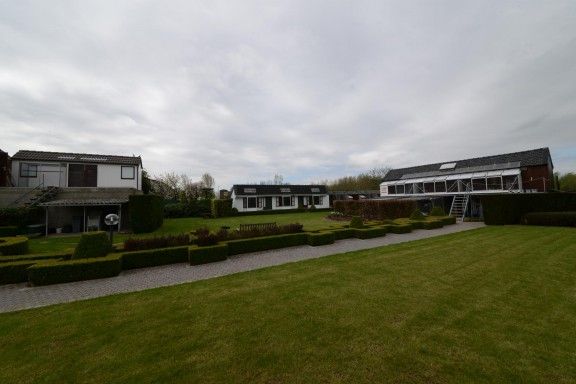
Males and females train an hour twice a day. The males have come during this time on the roof, fly up but immediately again. The females, however, fly through a full hour. After your daily workout, the females spend the day in an Aviary. In the aviary, there is not much space so that the females have to sit very close together. A pairing with each other is so impossible. In the evening the females in her "bedroom" switch. There they sit on shelves. Should females mate go the pigeons in a seperate eingekorbt be on Thursday. They train on Thursday morning to the shock before they are then fed at 10 o'clock. The cells are open and the birds go in the cells, then the females get in. After about an hour along the sexes be separated again. Is fed again two to three times in the afternoon. To get their traditional mixture, with in addition hemp and sunflower seeds. When the pigeons be used against 16:00 females come once again in the aisle before the male blow. Then the females will first eingekorbt, then the males.
Males and females are played every week on the large middle distance. The male of the race home come get 100% Koopman (mixture of heavy flights) and the product is top-fit in the drinking water. On Sunday, there are 50% Koopman mixture and 50% Vandenabeele mixture enriched with 4 oils and proteins. In drinking water back into top shape. On Monday, 100% Vandenabeele mixture as food and in drinking water a drug or Bronchofit. Tuesdays 50% Koopman mixture and 50% Vandenabeele mixture with a drug or Bronchofit in the drinking water. On Wednesday and Thursday, there is mixture in turn 100% Koopman and on Wednesday the multivitamin Aminovit in drinking water. Wednesday and Thursday a supplemented in addition 10% corn mix. After the daily training flights around the House, each bird gets a little hemp and sunflower seeds in the cell. Thanks to a balanced feeding and highly effective supplement products (top-fit - 4 oils - proteins) the doves recover very well and quickly. Not very many accessories are administered at the beginning of the season. The animals need more in the second half of the season. It is important to know that the product Super flight is very important for a fast recovery.
After the return of the race, birds and female stay together two to three hours. This period will be extended in the second half of the season, but the maximum is up to the next day. Generally, the female fly better than the birds. They are quiet in the basket and recover much faster than the males.
YOUNG PIGEONS
200 youngsters be discontinued until the end of March. Many youngsters are lost 40 to 50 of youngsters are again separately bred and trained to Soissons. Most of the young pigeons is bred from the breeders because the eggs of the "special breeder" to the racing pigeons are moved. The youngsters will be deposed at the age of 24 to 25 days and stay together until they've flown MOMIGNIES twice. Normally, the youngsters after the sliding door method but is traveled in 2014 a widower part and another part on nest will be played. The youngsters are darkened from March 7 to June at 16:00. After that is stopped with the darkening and the youngsters wake up with the sunrise. In 2013, the youngsters from 26 June until 22:30 and in the morning from 5:30 were exposed. Some dark corners are built to give the youngsters a special motivation. Also straw is scattered. Experience shows that youngsters should stay too long together before inserting. At the beginning of the season they stay together longer but once they know the system they come together only for one hour. They are then separated and get to eat fresh water and something. Then the sliding door is opened again and they will be basked. The young pigeons are trained as often as possible. In 2013 they were conditionally trained only four or five times by the bad weather conditions before they were played on MOMIGNIES. Then it went Soissons twice MOMIGNIES, twice, then on the middle distance and on the national flights. This applies to males and females.
Filip and Kristof agree that they were not strict enough with the youngsters. You would need to be trained more, because you need not even play youngsters who are not well trained. Normally, the youngsters between two award flights be trained two times a week. But last season was not done though Filip and Kristof know that this extra training is very good for the orientation and ensures that the young pigeons faster leaving the race. So, the situation that it 2013 a top season was but a less good in the year with the old birds and yearlings occurred with the youngsters.
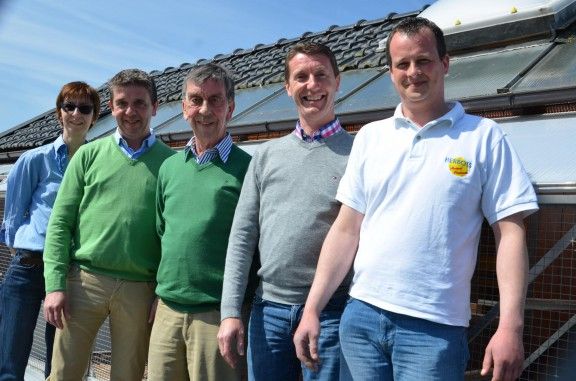
Over the whole season, the youngsters for 20 flights were basketed including the national flights. Each pigeon was invariably basked, and so they have selected themselves. Which did well were allowed to stay and have no place, with poor performance in Halle-Booienhoven.
The best youngsters are also the best year olds generally. A good year-old not good coming as old pigeon is stopped usually because he otherwise is in danger of destroying his entire career.
MEDICAL SUPPLY
After the season, a treatment is performed against cancer for about 5 to 7 days and then no treatments up to prepare for the new Zuchsaison the end of October. Then the breeders receive treatment against Parathyfus about 8 to 10 days and then they are vaccinated with a "live"vaccine. When the pigeons breed five days they get a Trichomonadenmittel during five days. In January the racers against Paramixo/pox and 3 weeks later Parathyfus followed vaccinated by a vaccination of 8 to 10 days later.
While the racers inspected every 3 weeks of the season and in 2013, the racers were two times with a Tricho Tablet treated and 2 or 3 times during two days against Ornithosis with a product by veterinary RAF Herbots. Prior special flights (2 or 3 times a year), the racers are treated with Paracoli (an antibiotic).
If the youngsters be discontinued get a Spartrix and an Appertex and be vaccinated against Paramixo and smallpox. Three weeks later, they are vaccinated against herpes virus. Vaccines result in better health and a better natural defences. Four weeks after stopping the youngsters get a seven-day course of treatment against cancer. Seven weeks after stopping a seven-day cure for Parathyfus followed by a vaccination. During the racing season, the young pigeons are treated the same as the old racers. While he received the large medium-haul flights the pigeons bio-eye-drops three to four times a week.
SELECTION
If you strictly selected its pigeon population to avoid an overpopulation and quality inhabited the blows. Only 30 of the 70 travel pairs survive the selection. Halfway through the season, the travel team is already reduced to 45 pairs. The bar is much higher for the youngsters. Only 70 to 80 youngsters get through the selection and this 250! Birds have to fly top prices and prices in the first 10% of the price list. Only when the youngsters it may well be that a dove without top prices but perfectly in the hand and born over the selection from a family of champions. This is the work of Jo and Kristof. Also a pigeon with a smart look can stay another year to show their qualities. "What is a good pigeon for you?", so the question for the Herbots team. "First of all we love a pigeon with a good expression. We are looking for the Dove with many and soft feathers and if we look at the eyes we want to see character. We want no doves with wings which you can put your finger and we want short upper arms. A good pigeon has a very good balance, is well connected and has a firm body. “
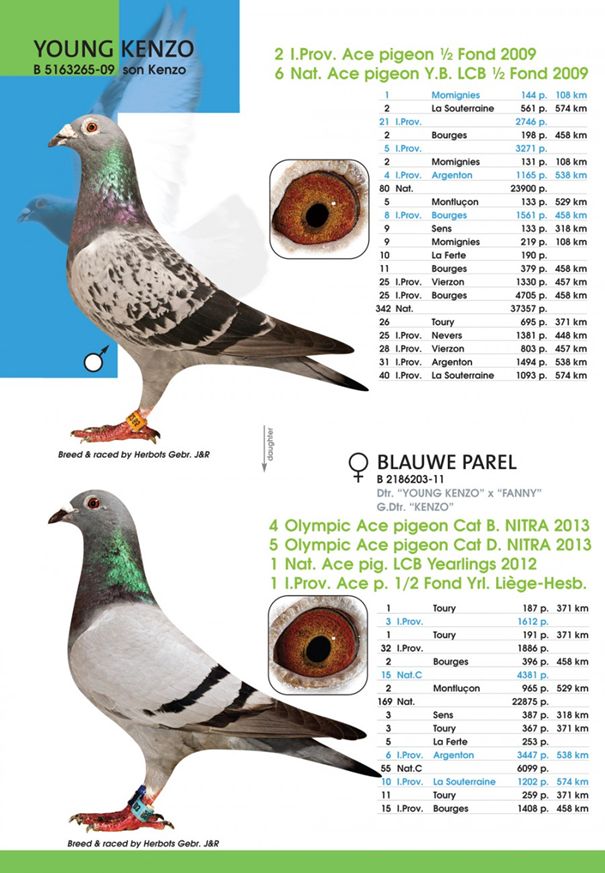
THE BREEDING LOFT
"If we operate family breeding exclusively for breeding and not for the trip. The most important breeding lines with us are: "Nationaal I" (Schellens) - 30% of our breeding stock is based on this line. "Yvan" (Deno/Vandenabeele/Vandersmissen) - 15% of our breeding stock is based on this line. The mother of the "Yvan" comes from the line of the "Nationaal I". Then we have the line of "155" (Grondelaers)... 20% of our breeding colony is based on this line. It is known that we preferred breed of pigeons, which themselves have an impressive track record. We are convinced that this is the more successful way. An example is the very successful breeding way of "Kenzo" (B04-2116092), 1 national AS pigeon middle distance KBDB 2007. We have been breeding the B09-5163264 and B09-5163264 x from "Kenzo" line of "155". ' 264/09' 09 best young pigeon of Belgium was about 4 national flights and "265/09" was 19 best young pigeon of Belgium on 4 national flights. The "265/09" is a real ACE and is father of "B11-2186203" which won top-Nationalpreise and 4th Olympiad pigeon 2013 was category B and 5th Olympiad pigeon category D in Nitra. The "264/09" was grandmother of B12 5046508 ": 1st National from Gueret and the quickest of the 27.542 pigeons.
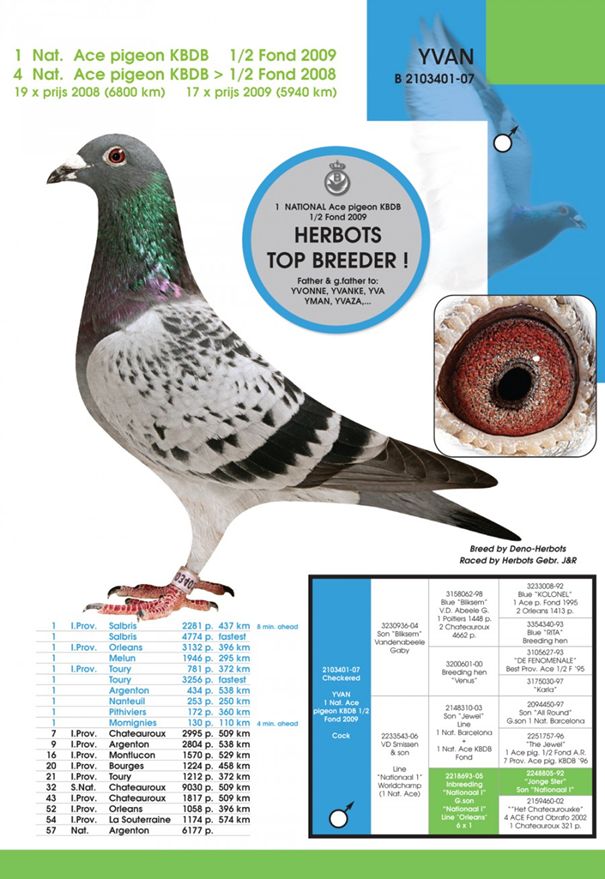
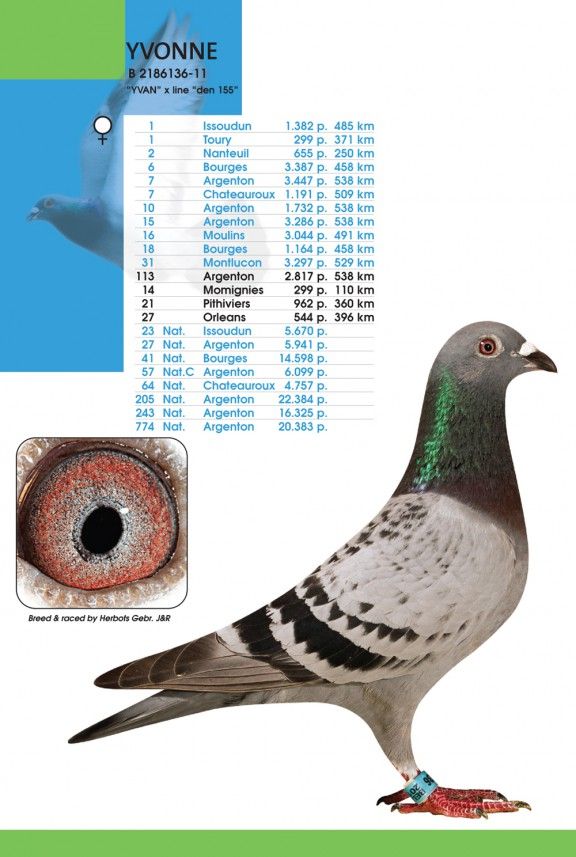
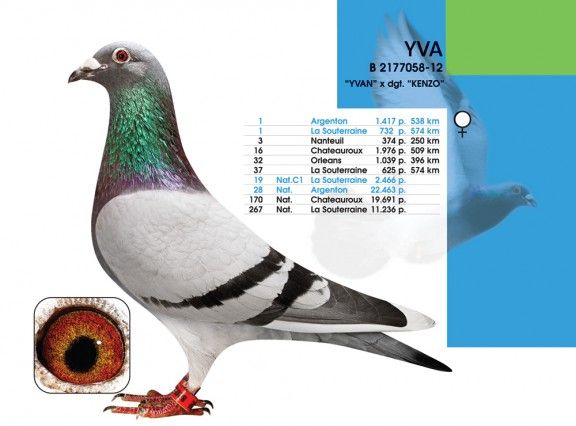
AVIARY FROM THE STROKES
There are 50 meters of travel shots. On all shots, breeding, and travel, oxygen is very important. We have installed aviaries (Habru) before all shots. The females are almost constantly in the Aviary only not when training the birds. The birds Monday to Sunday, and Tuesday in the dash or in the Aviary sit. on each stroke (old and young pigeons) we have installed ATX plates. It's too cold or too wet this turn. Even after a rainy race a few degrees have more temperature for pigeons and breeders.
A SUCCESSFUL TEAM
The impact community Herbots brothers consists of Jo, rental, RAF, Filip, Jacqueline, Cois, Kristof and Geoffrey. After the successful season of 2013, this team is very motivated and ambitious for the upcoming season.
A special thanks to the younger members of the team. Here we contact impact representative Jos Herbots and Geoffrey Janssens by Kristof Daniels, previously. Both are doing a top job and have "Pigeon's blood" in their veins. The future promises great for these two young impact Manager.




